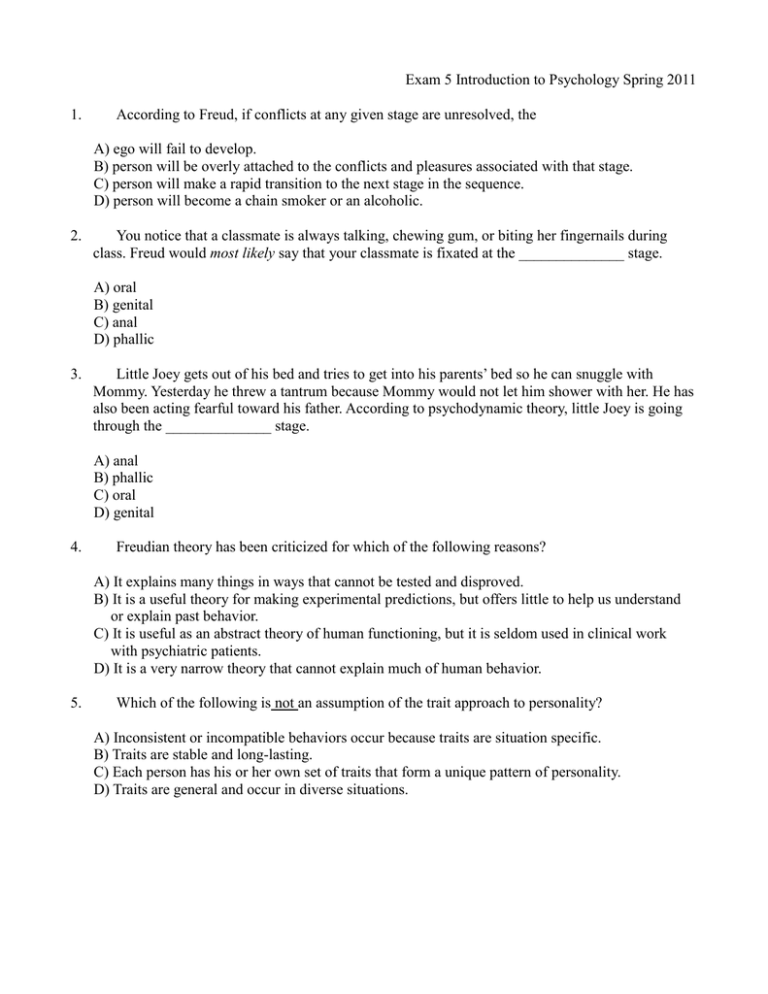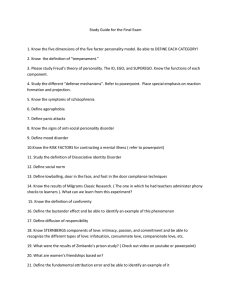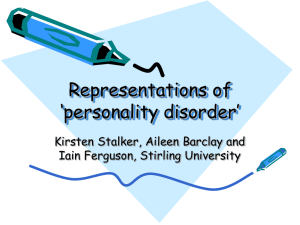Psychology Exam: Freud, Personality, Disorders, Attribution
advertisement

Exam 5 Introduction to Psychology Spring 2011 1. According to Freud, if conflicts at any given stage are unresolved, the A) ego will fail to develop. B) person will be overly attached to the conflicts and pleasures associated with that stage. C) person will make a rapid transition to the next stage in the sequence. D) person will become a chain smoker or an alcoholic. 2. You notice that a classmate is always talking, chewing gum, or biting her fingernails during class. Freud would most likely say that your classmate is fixated at the ______________ stage. A) oral B) genital C) anal D) phallic 3. Little Joey gets out of his bed and tries to get into his parents’ bed so he can snuggle with Mommy. Yesterday he threw a tantrum because Mommy would not let him shower with her. He has also been acting fearful toward his father. According to psychodynamic theory, little Joey is going through the ______________ stage. A) anal B) phallic C) oral D) genital 4. Freudian theory has been criticized for which of the following reasons? A) It explains many things in ways that cannot be tested and disproved. B) It is a useful theory for making experimental predictions, but offers little to help us understand or explain past behavior. C) It is useful as an abstract theory of human functioning, but it is seldom used in clinical work with psychiatric patients. D) It is a very narrow theory that cannot explain much of human behavior. 5. Which of the following is not an assumption of the trait approach to personality? A) Inconsistent or incompatible behaviors occur because traits are situation specific. B) Traits are stable and long-lasting. C) Each person has his or her own set of traits that form a unique pattern of personality. D) Traits are general and occur in diverse situations. 6. Buffy and Jody have spilled some food on the kitchen floor without cleaning it up. Mr. French says, “You are wretched, awful people because of the mess that you’ve made. Aren’t you ashamed?” According to Carl Rogers’s self theory, Mr. French is A) having a peak experience. B) creating conditions of worth. C) operating from a deficiency orientation. D) pursuing self-actualization. 7. Matilde is driven by her perceived need to acquire material things and therefore does not focus on the skills and experiences she does have. Maslow’s Humanistic theory of personality would suggest that she is controlled by A) self-actualization. B) conditions of worth. C) deficiency orientation. D) growth orientation. 8. Both the psychodynamic and humanistic theories of personality have been criticized for A) their psychotherapy techniques, which focus too much attention on overt behavior. B) concepts that are too vague to be scientific. C) being better at describing personality than at explaining it. D) placing too much emphasis on sexual determinants of personality development. 9. Dr. Johnson has created a new personality test that he claims is a valid measure of personality. However, the correlation between the scores of people who take the test on two occasions one week apart is negative. Obviously, this new test has problems with A) reliability. B) standardization. C) validity. D) confidentiality. 10. In a new personality test, subjects are asked to say what they think different cloud formations look like. One subject said a cloud looked like a chicken salad sandwich, but another subject said the same cloud looked like the late Generalissimo Francisco Franco. This personality test is least similar to A) the Minnesota Multiphasic Personality Inventory. B) a projective personality test. C) the Thematic Apperception Test. D) the Rorschach inkblot test. 11. One criticism of projective personality tests is that A) they fail to account for conditions of worth. B) the interpretation of results can vary subjectively from one tester to another. C) they are more accurate for divergent thinkers than for convergent thinkers. D) they are highly influenced by the id. 12. Mark can speak nine languages fluently. Mark’s ability would be considered abnormal according to which of the following criteria? A) Norm violation B) Infrequency C) All of the these D) Practical approach 13. Being able to play basketball at the skill level of Michael Jordan is very rare. Thus, Michael Jordan might be viewed as abnormal from the ______________ approach to defining abnormality. A) practical B) statistical infrequency C) personal suffering D) norm violation 14. Martin has been recently diagnosed with schizophrenia. Although Martin’s family has a history of schizophrenia, Martin only began displaying symptoms after he filed for bankruptcy, a very difficult time. The recent appearance of Martin’s disorder is best explained by the ______________ model of psychological disorders. A) cognitive-behavioral B) medical C) diathesis-stress D) psychodynamic 15. DSM-IV is a reference guide for A) prescribing psychoactive medication. B) resolving conflicts. C) treating abnormal behaviors. D) diagnosing mental disorders. 16. Linda is a psychologist who is trying to diagnose her patient’s psychological disorder. She knows that this might be difficult to do. Which of the following is not true about the difficulty in classifying disorders? A) The same symptoms often appear as part of more than one disorder. B) The DSM-IV gives general labels, such as neurosis and psychosis. C) Diagnostic judgments are somewhat subjective. D) People’s problems often do not fit neatly into one category. 17. Mr. Lecter was classified by several psychologists according to the Diagnostic and Statistical Manual of Mental Disorders (DSM-IV). One classified this problem as bipolar disorder, another as antisocial personality disorder, and a third as narcissistic personality disorder. These results indicate a problem of: A) Low interrater reliability B) Dehumanization of clients C) Low validity D) The self-fulfilling prophecy effect 18. Anxiety disorders are characterized by all of these symptoms except A) increased heart rate. B) a sense of dread. C) a split between affect and cognition. D) disruptions in daily functioning. 19. Nathan avoids speaking in public. He's extremely afraid of appearing stupid and can't stand the thought of being embarrassed. Nathan suffers from A) obsessive-compulsive disorder. B) agoraphobia. C) a social phobia. D) panic disorder. 20. For the past two months, Thomas has been worried that something bad is going to happen. He can't pinpoint the source of this feeling, but he is jumpy and irritable, and he can't sleep or concentrate. His symptoms suggest that he may be suffering from ______________ disorder. A) dissociative B) panic C) generalized anxiety D) conversion 21. Obsessive-compulsive disorder is characterized by A) excessive and long-lasting anxiety that is not focused on any particular object or situation. B) fear and avoidance of a specific situation or object. C) recurrent, terrifying panic attacks that come without warning or obvious cause. D) persistent and unwanted thoughts that motivate repetitive behaviors. 22. What is the major reason that phobias are maintained? A) Phobias are learned early in life. B) Avoidance responses prevent learning that can overcome fear. C) Avoidance responses are irrational. D) Phobias tend to multiply. 23. After experiencing abuse during her childhood, Fae developed several identities. Fae often switched between a character named Cassie, who was moody, withdrawn, and inarticulate, and a character named Val, who was unemotional, eloquent, and self-assured. Fae probably has A) bipolar disorder. B) a dissociative disorder. C) dysphoria. D) schizophrenia. 24. When Stephanie hears people speaking Chinese in a Chinese restaurant, she assumes that they are plotting against her. When she opens a fortune cookie, she thinks that the message inside was placed there by government officials who are watching her. Stephanie appears to be experiencing A) thought broadcasting. B) clang associations. C) word salad. D) ideas of reference. 25. Karen and Tai both suffer from schizophrenia. Karen keeps hearing voices coming from her food, whereas Tai is convinced that he is a space alien. Karen is having ______________, and Tai is suffering from ______________. A) delusions; hallucinations B) obsessions; ideas of reference C) hallucinations; delusions D) thought insertion; ideas of reference 26. Biological theories have focused on the role of which neurotransmitter in schizophrenia? A) Histamine B) Serotonin C) Norepinephrine D) Dopamine 27. Eli wears earmuffs all the time because he believes that they prevent aliens from stealing thoughts from out of his head. Eli is displaying the symptom known as thought A) broadcasting. B) dissociating. C) withdrawal. D) insertion. 28. Attribution theory is principally concerned with the A) comparison of ourselves with those around us. B) process of explaining the causes of people’s behavior. C) influence of the presence of others on performance. D) process of forming impressions of others. 29. Kelly’s mom is late in picking her up. Kelly believes her mom is late because her mother is just plain lazy and doesn’t care about time. In reality, her mother was late because of traffic tie-ups due to an accident. Kelly explains her mother’s behavior by using a(n) ______________ attribution. A) consistent B) internal C) fundamental D) external 30. When I trip on the stairs, I look around to see what I tripped on. When I see someone else trip on the stairs, I decide that the person is clumsy. I am demonstrating the A) self-serving bias. B) self-fulfilling prophecy. C) fundamental attribution error. D) actor-observer bias. 31. Lula believes she did poorly on her pogo stick exam because she was too busy studying for other exams to practice enough. However, she believes other people who scored low did so because they just don’t have the skill. Lula’s reasoning demonstrates the A) actor-observer bias. B) ultimate attribution error. C) consensus bias. D) self-serving bias. 32. You just spent two hours watching the performance artist Condor pop peas in the air one at a time and attempt to catch each pea in his mouth. You are so bored that you are ready to scream. Nonetheless, when the show ends and the rest of the audience gives Condor a standing ovation, you do the same. You have A) normed. B) conformed. C) obeyed. D) complied. 33. The members of Nu Nu sorority have decided to dress up for Halloween. Cindy, a new inductee, doesn’t really want to participate, but after listening to her sorority sisters’ begging her to dress up, she decides to go ahead and do it. This is an example of A) conformity. B) compliance. C) obedience. D) private acceptance. 34. While visiting a foreign country, Ana observes that all of the locals bow toward a certain building as they pass it. As she passes it, Ana bows too. Which of the following does not help to explain her behavior? A) Ana likes the people in that country. B) Many others had bowed. C) Ana is not familiar with the situation. D) Ana is female. 35. What is a delusion of reference? 4pts Coincidental experience is thought to be meaningful to only you, know one else. This question caught people off guard, so I changed it to extra credit. 36. In the Humanistic approach of Carl Rogers, why would being raised under “conditions of worth” lead to depression or anxiety? 8 pts Conditions of worth are expectations of others that you must meet in order to receive love and approval. Depression can occur because one gives up their own interests and wants to meet other's wants, which leads to a form of mourning (of the life you could have lived, the one you wanted). Anxiety is what comes when you are constantly trying to figure out and meet the expectations of others with some doubt of your ability to do so. 37. What are the 3 components of an attitude? Please define them. 6 pts Thoughts, feelings, actions. So, the thoughts include beliefs and propositions (lawyers are crooks), and emotional judgment, (crooked lawyers are a good thing), while actions are the behaviors that are consistent with the other components (I want to be a lawyer and work for Enron). 38. If Cognitive Dissonance does not influence people’s attitude through the central or peripheral route, why do people change their attitudes as a result? 8 pts Experience and the emotional turmoil of being a hypocrite. If the central route is “just the facts persuade people” while the peripheral route persuades people for superficial reasons, the power of cognitive dissonance comes by way of having acted in a way that is inconsistent with one's attitude, hence the emotional turmoil, and we are motivated to do what we can to reduce it. 1. [B) 2. [A) 3. [B) 4. [A) 5. [A) 6. [B) 7. [C) 8. [B) 9. [A) 10. [A) 11. [B) 12. [B) 13. [B) 14. [C) 15. [D) 16. [B) 17. [A) 18. C 19. C 20. C 21. D 22. B 23. B 24. D 25. C 26. D 27. A 28. [B) 29. [B) 30. [D) 31. [A) 32. [B) 33. [B) 34. [D)



